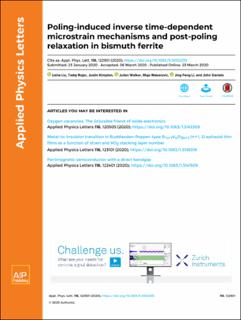Poling-induced inverse time-dependent microstrain mechanisms and post-poling relaxation in bismuth ferrite
Liu, Lisha; Rojac, Tadej; Kimpton, Justin; Walker, Julian; Makarovic, Maja; Li, Jing-Feng; Daniels, John E.
Peer reviewed, Journal article
Published version

Åpne
Permanent lenke
https://hdl.handle.net/11250/2735241Utgivelsesdato
2020Metadata
Vis full innførselSamlinger
- Institutt for materialteknologi [2555]
- Publikasjoner fra CRIStin - NTNU [38576]
Sammendrag
Domain-wall dynamics under strong, super-coercive electric fields in polycrystalline bismuth ferrite (BiFeO3) are not well established due to the experimental difficulties in processing high phase purity perovskite with low electrical conductivity. Overcoming these difficulties, here we present x-ray diffraction measurements carried out in situ during electrical poling with a trapezoidal electric-field to investigate the domain wall dynamics and lattice strain in this material. It is observed that during field ramping, microscopic strains, i.e., non-180° domain texture and lattice strain, increase simultaneously. During DC field dwell, however, a lattice strain decrease occurs over time, accompanied by an increase in the non-180° domain texture. This inverse time-dependent trend of microscopic strain mechanisms is speculated to be due to mobile charged defects residing in domain wall regions. The configuration of these charged point defects may also play a role in the observed post-poling relaxations of non-180° domain texture and macroscopic piezoelectric coefficients on removal of the field. Since conducting domain walls have been recently identified in a number of ferroelectrics, these results should significantly impact the understanding of strain mechanisms not only in BiFeO3 but on a broader range of ferroelectric materials.